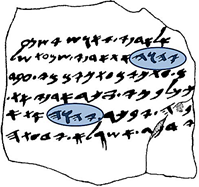Between 1935-38, James L. Starkey dug around an old gate into two feet of ash and debris and unearthed 18 pottery sherds written in black carbon ink at the Lachish excavations (picture, below). Archaeologists were excited because it provided a pre-exile form of ancient Hebrew script. Bible students were equally excited because the content parallels the Bible’s record of public opinion on Jeremiah’s messages.

Historically, Jeremiah prophesied 41 years in Jerusalem from the reign of king Josiah until the deportation of king Zedekiah into Babylon. As a prophet and priest, he stood practically alone with his message of doom: because of Manasseh’s sinful abominations, Judah will surely fall to the Babylonians. Defect to king Nebuchadnezzar and live. Resist and die of the sword and famine in the city which will burn with fire. Needless to say, he was hated by all: pastors, priests, princes, the people, and certainly the false prophets declaring a sure victory. Though they heard his message, they took it the wrong way: the princes said unto the king, We beseech thee, let this man be put to death: for thus he weakeneth the hands of the men of war that remain in this city, and the hands of all the people, in speaking such words unto them: for this man seeketh not the welfare of this people, but the hurt.
 |
|
Map showing location of Jerusalem's two important southern defense cities. |
Elsewhere, at a southern Judean military outpost, a soldier named Hoshaiah writes a report on clay tablets to his commander Yaosh stationed at the defense city of Lachish, informing him that: (i) the Babylonians are attacking, (ii) he cannot see the signal fire at Azekah, one of two remaining defense cities (cp. Jer. 34:7, see right); and (iii) an army commander has been sent to Egypt (cp. Ezek. 17:15-16). The soldier often appeals to YHWH (see picture below), and mentions others such as Elnathan, Jaazaniah, Neriah, and Gemariah — all biblical names of that time period (cp. Jer. 36:12, 35:3; 32:12; 36:10). Even Hoshaiah’s name is in the Bible (cp. Jer. 42:1) but may not be the same man.
 |
|
Lachish Letter II. The divine name YHWH (Yahweh, or Jehovah) is circled. |
Most striking is his complaint of Jeremiah’s words in Letter 6: “Read, I pray thee, and (thou wilt) see (that) the words of the [prophet*] are not good, (liable) to weaken the hands, [to make] sink the hands of the coun[try and] the city.” Some speculate “the prophet” to be Urijah who had a similar gloomy message (cp. Jer. 26:20), but he lived long before the Babylonian assaults. A fragment from a different tablet specifies “[…i]ah the prophet”, while another says “[Je]remiah”.
It is a rare treasure to find official Judean military letters, replete with period-specific names plus a reference to a major Bible prophet, during an intense time of Hebrew history. The writer’s emotions, concerns, fear and sense of duty all sparkle from the hardened clay.
If only they had listened to Jeremiah. Is it any different today?
*Secular archaeologists translate “prophet” as “officers” in Letter 6.
Sources: Nabatea.net, ADefenseOfTheBible.com, and Bible Reading Archaeology. The first source is highly intriguing and worth reading.
Like this? Consider sharing it to Facebook by clicking the linked icon below.
